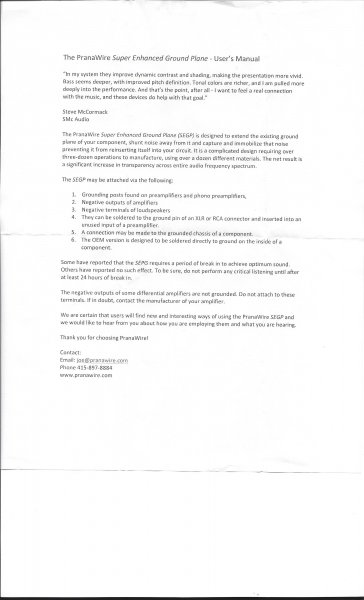Thanks, Audiocrack! Always respect your substantial experience and measured evaluations. I have heard your system, and 'calibrated' your ear which is very refined. Your system also is comprised of a unique mix of elements, some of which are decidedly NOT for pride, ego...but simply because they sound better. I respect that, and its reassuring to know when reading one of your evaluations. You care about the sound, not the name brand or the pricetag.
I have heard Tripoint in an AE system in Hong Kong...hooked up to a full-out, all-out assault Tidal system (4-towers) and six boxes of Tidal reference amplification, 2-box preamp and the Stahl-Tek Vekian digital system. Power was already fed via dedicated lines. The Troy was hooked up to almost 9 components as I recall...they removed one. And sure enough, there was a haze equivalent to moving from Transp Ref IC to, say, one of my old Audioquest Emerald ICs...great voice, rich, smooth...but hazy.
but I cannot say I've heard it in my system. I have however heard the Entreq Silver Tellus in my system where I've described it elsewhere in WBF...and it has a similar effect as what you describe. The mechanics of the system decrease even more...though I also did hear an actual improvement in detail/decay which was very nice. It is a great piece that had no discernible downsides...and I could certainly qualify it as something that I could see keeping well past other components.
Great write up, Audiocrack...and enjoy your fabulous system!!!
I have heard Tripoint in an AE system in Hong Kong...hooked up to a full-out, all-out assault Tidal system (4-towers) and six boxes of Tidal reference amplification, 2-box preamp and the Stahl-Tek Vekian digital system. Power was already fed via dedicated lines. The Troy was hooked up to almost 9 components as I recall...they removed one. And sure enough, there was a haze equivalent to moving from Transp Ref IC to, say, one of my old Audioquest Emerald ICs...great voice, rich, smooth...but hazy.
but I cannot say I've heard it in my system. I have however heard the Entreq Silver Tellus in my system where I've described it elsewhere in WBF...and it has a similar effect as what you describe. The mechanics of the system decrease even more...though I also did hear an actual improvement in detail/decay which was very nice. It is a great piece that had no discernible downsides...and I could certainly qualify it as something that I could see keeping well past other components.
Great write up, Audiocrack...and enjoy your fabulous system!!!








